Each year we look forward to reading the first books by children’s and young adult authors and illustrators. In this week’s column we review debut picture books and novels that caught our attention and left us eagerly anticipating the next literary offerings of these authors and illustrators.
Ages 4–8
Dust Bunny Wants a Friend. Amy Hevron. 2019. Schwartz & Wade/Random House.
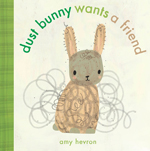 Everyone craves love, even a lone dust bunny under a chair. In this almost wordless book (words are limited to “hi,” “bye,” “achoo,” and “byeee!”), Amy Hevron makes her debut as an author with the story of a little dust bunny seeking friendship with all the wrong creatures (a bug, ants, a cat, a teddy bear) which gives young bookworms lots to “read” in the humorous and colorful illustrations (rendered in acrylic and marker on wood and collaged digitally). When Dust Bunny finds himself swept under a bed by a broom, he finally discovers his people, a community of dust bunnies who happily welcome him.
Everyone craves love, even a lone dust bunny under a chair. In this almost wordless book (words are limited to “hi,” “bye,” “achoo,” and “byeee!”), Amy Hevron makes her debut as an author with the story of a little dust bunny seeking friendship with all the wrong creatures (a bug, ants, a cat, a teddy bear) which gives young bookworms lots to “read” in the humorous and colorful illustrations (rendered in acrylic and marker on wood and collaged digitally). When Dust Bunny finds himself swept under a bed by a broom, he finally discovers his people, a community of dust bunnies who happily welcome him.
—NB
How to Walk an Ant. Cindy Derby. 2019. Roaring Brook/Macmillan.
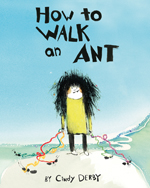 Amariyah, a self-proclaimed Expert Walker, shares with readers her very own nine-step “How to Walk an Ant” guide with handwritten instructions, tips, rules, and occasional footnotes. Debut author–illustrator Cindy Derby’s black ink-and-watercolor artwork with a distinctive goth vibe shows Amariyah working her way through the steps, including securing a leash to an ant and practicing walking it. A collision with a ladybug walker results in a tangle of leashes (and the need to reference “How to Conduct a Funeral” in the appendix) before step nine: “Celebrate when you reach your goal,” which Amariyah does with her new friend and business partner.
Amariyah, a self-proclaimed Expert Walker, shares with readers her very own nine-step “How to Walk an Ant” guide with handwritten instructions, tips, rules, and occasional footnotes. Debut author–illustrator Cindy Derby’s black ink-and-watercolor artwork with a distinctive goth vibe shows Amariyah working her way through the steps, including securing a leash to an ant and practicing walking it. A collision with a ladybug walker results in a tangle of leashes (and the need to reference “How to Conduct a Funeral” in the appendix) before step nine: “Celebrate when you reach your goal,” which Amariyah does with her new friend and business partner.
—CA
Ruby’s Sword. Jacqueline Véissid. Ill. Paola Zakimi. 2019. Chronicle.
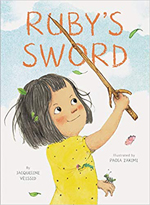 Ruby’s brothers consider her a pest and always leave her behind. One day, Ruby finds three “swords” (long sticks hidden in the grass), gives two of them to her brothers so they will “swashbuckle” with her, and, after they run off without her, uses her imagination to fight a dragon, have a royal feast, and save loyal subjects all on her own. When she begins building a castle with sticks and a sheet, her brothers return with “honorable offerings” (twigs, rocks, dandelions, their swords), and together they build a magnificent castle perfect for three noble knights. Argentinian illustrator Paola Zakimi’s illustrations, rendered in watercolor and pencil as well as digitally, capture the challenges and sweetness of sibling relationships in author Jacqueline Véissid’s first book.
Ruby’s brothers consider her a pest and always leave her behind. One day, Ruby finds three “swords” (long sticks hidden in the grass), gives two of them to her brothers so they will “swashbuckle” with her, and, after they run off without her, uses her imagination to fight a dragon, have a royal feast, and save loyal subjects all on her own. When she begins building a castle with sticks and a sheet, her brothers return with “honorable offerings” (twigs, rocks, dandelions, their swords), and together they build a magnificent castle perfect for three noble knights. Argentinian illustrator Paola Zakimi’s illustrations, rendered in watercolor and pencil as well as digitally, capture the challenges and sweetness of sibling relationships in author Jacqueline Véissid’s first book.
—NB
Snakes on a Train. Kathryn Dennis. 2019. Feiwel and Friends/Macmillan.
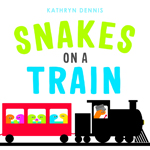 “The conductor takes the tickets / as the snakes all slither on. / The tracks are checked. / The whistle blows. It’s time to move along. / Hissssssssssssssss goes the sound of the train.” The rhythmic text with a repetitive refrain and graphic illustrations with simple shapes and bold colors of Kathryn Dennis’ first picture book take young children on a day-long train trip with carloads of snake passengers reading books, enjoying snacks, and gazing at the scenery. At the end of the journey, as the snakes slither off to sleep in their dens, “the train rests for the night. / Snakes wrap themselves in little balls / and tuck their tails in tight. / Ssssssssssssssssh goes the sound of the train.”
“The conductor takes the tickets / as the snakes all slither on. / The tracks are checked. / The whistle blows. It’s time to move along. / Hissssssssssssssss goes the sound of the train.” The rhythmic text with a repetitive refrain and graphic illustrations with simple shapes and bold colors of Kathryn Dennis’ first picture book take young children on a day-long train trip with carloads of snake passengers reading books, enjoying snacks, and gazing at the scenery. At the end of the journey, as the snakes slither off to sleep in their dens, “the train rests for the night. / Snakes wrap themselves in little balls / and tuck their tails in tight. / Ssssssssssssssssh goes the sound of the train.”
—CA
Spencer and Vincent, the Jellyfish Brothers. Tony Johnston. Ill. Emily Dove. 2019. Paula Wiseman/Simon & Schuster.
 Jellyfish siblings Spencer and Vince share a special ditty: “My brother, my brother, / he’s sweet, not smelly. / I love him from down in / my jelly belly.” After Vincent disappears in a wave of “superior magnitude,” Spencer asks friends (a whale, mermaid, seahorse, and sea star) to help locate him, and with Spencer’s singing of their special song for encouragement and a helpful smack of the water by the whale, Vincent, so weak he can barely “slurp” forward, floats back to Spencer. “In a tenderness of tentacles the brothers clasped each other, an embrace of superior magnitude.” Debut illustrator Emily Dove’s imaginative illustrations, rendered digitally and with watercolor in oceanic hues, work in tandem with Tony Johnston’s clever text. An author’s note provides information about jellyfish.
Jellyfish siblings Spencer and Vince share a special ditty: “My brother, my brother, / he’s sweet, not smelly. / I love him from down in / my jelly belly.” After Vincent disappears in a wave of “superior magnitude,” Spencer asks friends (a whale, mermaid, seahorse, and sea star) to help locate him, and with Spencer’s singing of their special song for encouragement and a helpful smack of the water by the whale, Vincent, so weak he can barely “slurp” forward, floats back to Spencer. “In a tenderness of tentacles the brothers clasped each other, an embrace of superior magnitude.” Debut illustrator Emily Dove’s imaginative illustrations, rendered digitally and with watercolor in oceanic hues, work in tandem with Tony Johnston’s clever text. An author’s note provides information about jellyfish.
—NB
Ages 9–11.
Hurricane Season. Nicole Melleby. 2019. Algonquin.
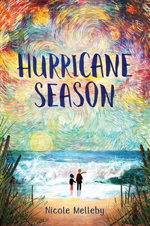 It is storm season, and 11-year-old Fig fears the arrival of a hurricane that would draw her father (who has an undiagnosed bipolar disorder) to the dangerous beach of their New Jersey coastal town during a manic state. Her father, a once-accomplished pianist and composer, has not performed or written music since Fig’s birth, after which his wife abandoned them. In doing research for an art project on Vincent van Gogh, Fig sees similarities in the mood swings of her father and Van Gogh as well as parallels in their father–daughter relationship with that of the painter and his brother Theo. As a relationship between her father and a new neighbor, Mark, grows, Ruby is conflicted. Mark has a calming effect on her father, but is he interfering with the special bond she has with her father, who has always depended on her alone? Debut author Nicole Melleby’s novel is beautifully written, realistic, and thought-provoking.
It is storm season, and 11-year-old Fig fears the arrival of a hurricane that would draw her father (who has an undiagnosed bipolar disorder) to the dangerous beach of their New Jersey coastal town during a manic state. Her father, a once-accomplished pianist and composer, has not performed or written music since Fig’s birth, after which his wife abandoned them. In doing research for an art project on Vincent van Gogh, Fig sees similarities in the mood swings of her father and Van Gogh as well as parallels in their father–daughter relationship with that of the painter and his brother Theo. As a relationship between her father and a new neighbor, Mark, grows, Ruby is conflicted. Mark has a calming effect on her father, but is he interfering with the special bond she has with her father, who has always depended on her alone? Debut author Nicole Melleby’s novel is beautifully written, realistic, and thought-provoking.
—CA
Ruby in the Sky. Jeanne Zulick Ferruolo. 2019. Farrar, Straus and Giroux/Macmillan.
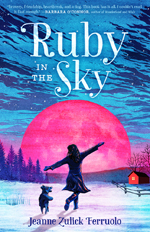 Ruby Moon Hayes and her mother have just moved to the small town of Fortin, Vermont. They never stay long in any one place so Ruby plans to be “invisible” and not involved until she convinces her mother to return to Washington, DC, their home before her father, a police officer, was killed. Although not intending to, Ruby becomes friends with Abigail Jacobs, the reclusive “bird lady” who is considered a town nuisance by the mayor. Finding the courage to speak as Abigail in front of the whole town at the sixth grade’s Wax Museum project, in which the students imitate historical figures, is just what Ruby needs to do to make Fortin her true “forever home.” Ruby in the Sky is Jeanne Zulick Ferruolo’s first novel.
Ruby Moon Hayes and her mother have just moved to the small town of Fortin, Vermont. They never stay long in any one place so Ruby plans to be “invisible” and not involved until she convinces her mother to return to Washington, DC, their home before her father, a police officer, was killed. Although not intending to, Ruby becomes friends with Abigail Jacobs, the reclusive “bird lady” who is considered a town nuisance by the mayor. Finding the courage to speak as Abigail in front of the whole town at the sixth grade’s Wax Museum project, in which the students imitate historical figures, is just what Ruby needs to do to make Fortin her true “forever home.” Ruby in the Sky is Jeanne Zulick Ferruolo’s first novel.
—CA
The Simple Art of Flying. Cory Leonardo. 2019. Aladdin/Simon & Schuster.
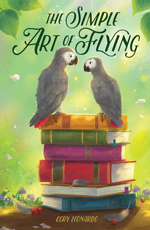 Debut author Cory Leonardo’s characters are working their way through losses. Alastair, a cantankerous grey parrot, who composes original poetry based on books he’s eaten, longs to escape to a faraway island with Aggie, the sister he’s been separated from. Twelve-year-old Fritz, who journals about ailing animals he cares for at the pet store where he works part time and misses his deceased grandfather, adopts Aggie. Eccentric, 80-year-old Albertina Plopky, who writes letters to her dearly departed husband, adopts Alastair. Leonardo uses free verse poetry, letters, and narrative with zippy dialogue in the different storylines of her engaging middle-grade work of magical realism, which ends with Alastair concluding, “You don’t always get everything you want in this life. But sometimes what you do get is better than you imagined…”
Debut author Cory Leonardo’s characters are working their way through losses. Alastair, a cantankerous grey parrot, who composes original poetry based on books he’s eaten, longs to escape to a faraway island with Aggie, the sister he’s been separated from. Twelve-year-old Fritz, who journals about ailing animals he cares for at the pet store where he works part time and misses his deceased grandfather, adopts Aggie. Eccentric, 80-year-old Albertina Plopky, who writes letters to her dearly departed husband, adopts Alastair. Leonardo uses free verse poetry, letters, and narrative with zippy dialogue in the different storylines of her engaging middle-grade work of magical realism, which ends with Alastair concluding, “You don’t always get everything you want in this life. But sometimes what you do get is better than you imagined…”
—NB
Ages 12–14
Cursed. Karol Ruth Silverstein.2019. Charlesbridge Teen/Charlesbridge.
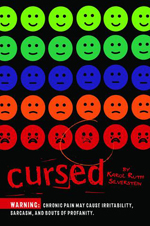 Fourteen-year-old Ricky Bloom was recently diagnosed with juvenile rheumatoid arthritis. Since her parents’ divorce, her mother has sent her to sleep on a sofa couch at her father’s “Batch Pad,” and she’s attending a new school where she’s bullied. Ricky curses everyone around her, and after a truancy streak and swearing at Mr. Jenkins, her public speaking teacher, she may flunk ninth grade. Through the unexpected help of Mr. Jenkins (and his afterschool assignment make-up sessions) and new friend, Oliver (a cancer survivor), she learns that words have power and that sometimes the most important one is “help.” Debut author Karol Silverstein drew upon personal experiences with juvenile arthritis in writing her first novel.
Fourteen-year-old Ricky Bloom was recently diagnosed with juvenile rheumatoid arthritis. Since her parents’ divorce, her mother has sent her to sleep on a sofa couch at her father’s “Batch Pad,” and she’s attending a new school where she’s bullied. Ricky curses everyone around her, and after a truancy streak and swearing at Mr. Jenkins, her public speaking teacher, she may flunk ninth grade. Through the unexpected help of Mr. Jenkins (and his afterschool assignment make-up sessions) and new friend, Oliver (a cancer survivor), she learns that words have power and that sometimes the most important one is “help.” Debut author Karol Silverstein drew upon personal experiences with juvenile arthritis in writing her first novel.
—NB
The Line Tender. Kate Allen. 2019. Dutton/Penguin.
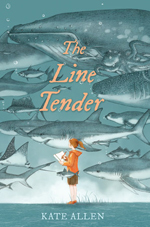 When local fisherman Sookie catches a great white shark in his net off Rockport, Massachusetts, 12-year-old artistic Lucy and her best friend, science-savvy Fred, want to include the great white in their summer project, an illustrated field guide. Then Fred drowns during a nighttime swimming party in a nearby quarry, and his body is recovered by Lucy’s dad, a member of the police dive team. Learning how research currently being done on the relationship of the great white shark and gray seal in the Cape Cod area is related to a study proposed by her mother, a shark biologist, just before her death when Lucy was 7, becomes a way for Lucy, her depressed father, Sookie (a family friend), and Mr. Patterson (an elderly widower and neighbor) to connect and deal with grief over what they have lost. Each chapter in Kate Allen’s debut novel is introduced with a double-page pencil sketch of a shark.
When local fisherman Sookie catches a great white shark in his net off Rockport, Massachusetts, 12-year-old artistic Lucy and her best friend, science-savvy Fred, want to include the great white in their summer project, an illustrated field guide. Then Fred drowns during a nighttime swimming party in a nearby quarry, and his body is recovered by Lucy’s dad, a member of the police dive team. Learning how research currently being done on the relationship of the great white shark and gray seal in the Cape Cod area is related to a study proposed by her mother, a shark biologist, just before her death when Lucy was 7, becomes a way for Lucy, her depressed father, Sookie (a family friend), and Mr. Patterson (an elderly widower and neighbor) to connect and deal with grief over what they have lost. Each chapter in Kate Allen’s debut novel is introduced with a double-page pencil sketch of a shark.
—CA
Ages 15+
Four Dead Queens. Astrid Scholte. 2019. Putnam/Penguin.
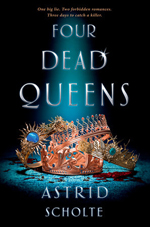 Seventeen-year-old Keralie, a Torian skilled thief working with her childhood friend Mackiel and Varian Boltt, an Eonist messenger, become unlikely allies when his attempt to reclaim a case of comm chips with embedded memories she stole from him outside the Concord (where the queens of Toria, Eonia, Ludia, and Archia, the four Quadrants of Quadara, live and rule) leads to their shared knowledge of the memory embedded in the comm chips of the killing of the four queens and their subsequent life-endangering involvement in uncovering the identity of the assassins and who is behind the diabolical conspiracy. With masterful worldbuilding and complex timeline manipulation accomplished through alternating points of view, Astrid Sholte creates an action-packed suspenseful novel that will intrigue and delight both fantasy and mystery fans.
Seventeen-year-old Keralie, a Torian skilled thief working with her childhood friend Mackiel and Varian Boltt, an Eonist messenger, become unlikely allies when his attempt to reclaim a case of comm chips with embedded memories she stole from him outside the Concord (where the queens of Toria, Eonia, Ludia, and Archia, the four Quadrants of Quadara, live and rule) leads to their shared knowledge of the memory embedded in the comm chips of the killing of the four queens and their subsequent life-endangering involvement in uncovering the identity of the assassins and who is behind the diabolical conspiracy. With masterful worldbuilding and complex timeline manipulation accomplished through alternating points of view, Astrid Sholte creates an action-packed suspenseful novel that will intrigue and delight both fantasy and mystery fans.
—CA
Genesis Begins Again. Alicia D. Williams. 2019. Caitlyn Dlouhy/Atheneum/Simon & Schuster.
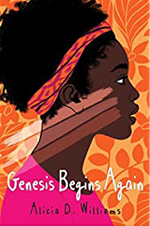 Thirteen-year-old Genesis Anderson adds what she dislikes about herself to “100 Reasons Why We Hate Genesis” (created by two girls in her fifth-grade class), including her hair and skin color. When her troubled father doesn’t pay the rent and they are evicted, she and her mother temporarily live with her grandmother, who tells her that only light-skinned blacks succeed. After her dark-skinned father finagles another home in which she, her mother (who could almost pass for white), and him to live together, and Genesis attends a suburban school of mostly white students where she struggles to fit in by straightening her hair with frenemies and secretly trying to lighten her skin. After she develops relationships with two new friends and her music teacher who don’t care about these things, Genesis finds her voice, literally and psychologically, as she performs a medley of songs from Billie Holiday, Ella Fitzgerald, and Etta James for the school talent show. Debut author Alicia Williams draws on personal experience as she takes on sensitive issues of “colorism” (color prejudice) from outside, and inside, the African American community.
Thirteen-year-old Genesis Anderson adds what she dislikes about herself to “100 Reasons Why We Hate Genesis” (created by two girls in her fifth-grade class), including her hair and skin color. When her troubled father doesn’t pay the rent and they are evicted, she and her mother temporarily live with her grandmother, who tells her that only light-skinned blacks succeed. After her dark-skinned father finagles another home in which she, her mother (who could almost pass for white), and him to live together, and Genesis attends a suburban school of mostly white students where she struggles to fit in by straightening her hair with frenemies and secretly trying to lighten her skin. After she develops relationships with two new friends and her music teacher who don’t care about these things, Genesis finds her voice, literally and psychologically, as she performs a medley of songs from Billie Holiday, Ella Fitzgerald, and Etta James for the school talent show. Debut author Alicia Williams draws on personal experience as she takes on sensitive issues of “colorism” (color prejudice) from outside, and inside, the African American community.
—NB
Nancy Brashear is Professor Emeritus of English, Azusa Pacific University, in Azusa, California. Carolyn Angus is former director of the George G. Stone Center for Children's Books, Claremont Graduate University, in Claremont, California.